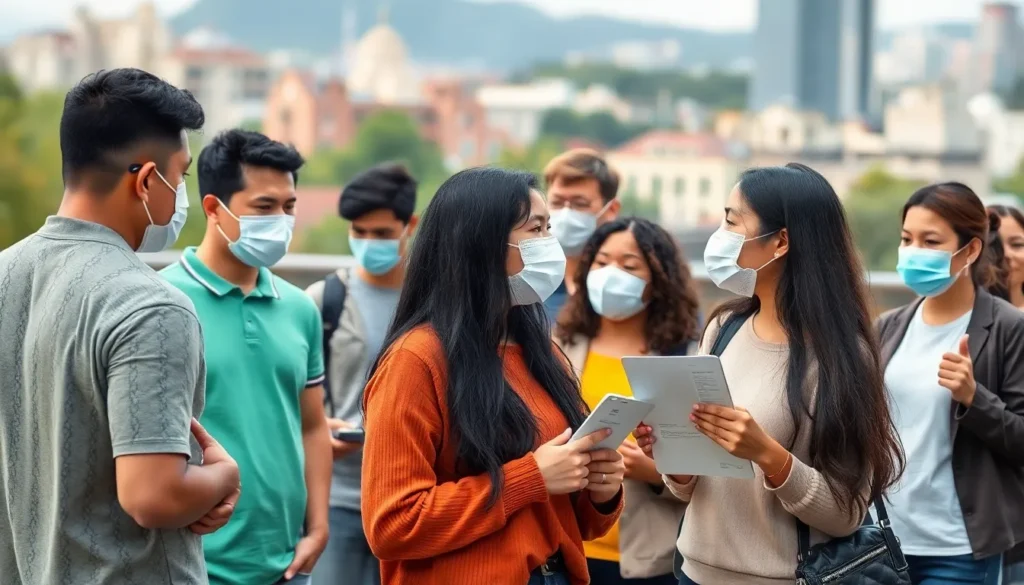Table of Contents
ToggleThe world has been shaken by pandemics throughout history, each leaving a profound impact on societies and economies. As recent events remind us of our vulnerability, the question arises: are we going to face another pandemic? With emerging diseases and global travel becoming more interconnected, the threat is ever-present.
Experts warn that the conditions for future outbreaks are already in place. Factors like climate change, urbanization, and wildlife trade contribute to the rise of new pathogens. Understanding these dynamics is crucial for preparing for what may come next. As communities navigate the aftermath of the COVID-19 pandemic, vigilance and proactive measures will be key in addressing the potential for future health crises.
Overview Of Past Pandemics
Pandemics have shaped societies throughout history, influencing health, economies, and social structures. Analyzing past outbreaks offers insights into preparedness for future health crises.
Historical Context
Pandemics like the Black Death (1347-1351), the Spanish Flu (1918-1919), and more recently, HIV/AIDS have had profound effects on populations. The Black Death led to the deaths of approximately 25 million people, altering demographic and economic landscapes. The Spanish Flu infected about one-third of the world’s population, causing roughly 50 million deaths. These historical events illustrate the far-reaching consequences of pandemics on human behavior, economic stability, and public health systems.
Lessons Learned
Several key lessons emerge from past pandemics.
- Surveillance systems are crucial. Effective disease tracking and reporting can limit outbreaks.
- Public health messaging matters. Clear communication during a health crisis fosters compliance and community cooperation.
- Investing in healthcare infrastructure is essential. Robust healthcare systems enable rapid response measures during outbreaks.
- Global collaboration is necessary. Coordinated international efforts enhance the capacity to manage pandemics.
- Equity in healthcare access is vital. Vulnerable populations often face higher risks, necessitating targeted interventions.
Understanding these lessons helps societies navigate the complexities of potential future pandemics.
Emergence Of New Pathogens

The emergence of new pathogens represents a significant threat to global health. Understanding the contributing factors and the role of climate change in this context is crucial for preparedness.
Factors Contributing To Outbreaks
- Human Activity: Urbanization accelerates contact between animals and humans, increasing disease transmission potential.
- Wildlife Trade: The illegal wildlife trade exposes humans to zoonotic diseases, heightening the risk of outbreaks.
- Global Travel: International travel facilitates rapid pathogen spread, allowing diseases to cross borders swiftly.
- Antibiotic Resistance: The overuse of antibiotics leads to resistant strains, complicating treatment and control efforts.
- Population Density: High population density in urban areas fosters the quick spread of infectious diseases.
Role Of Climate Change
- Temperature Increases: Rising temperatures expand the habitat range for disease vectors like mosquitoes, increasing transmission rates.
- Extreme Weather Events: Floods and droughts disrupt ecosystems, forcing wildlife into closer contact with human populations.
- Altered Migration Patterns: Climate change influences animal migration, which can introduce new pathogens to naïve populations.
- Food Security Challenges: Disruptions to food sources may lead to malnutrition, weakening immune systems and increasing vulnerability to diseases.
- Flooding and Contamination: Increased rainfall can lead to contaminated water supplies, raising the risk of waterborne diseases.
Current Global Health Preparedness
Global health preparedness involves proactive strategies and systems designed to detect and respond to potential pandemics. Strengthening this readiness is crucial for mitigating the impact of future outbreaks.
Surveillance Systems
Surveillance systems play a vital role in identifying and monitoring infectious diseases. Robust systems rely on real-time data collection from multiple sources, such as hospitals, laboratories, and field reports. Effective surveillance enables early detection of unusual disease patterns, fostering rapid response measures. The establishment of global surveillance networks, such as the Global Outbreak Alert and Response Network (GOARN), enhances collaboration among nations, ensuring timely sharing of critical information. Integrating modern technologies, like artificial intelligence and machine learning, improves data analysis and prediction capabilities, essential for preempting outbreaks.
Vaccine Development
Vaccine development remains a cornerstone of pandemic preparedness. Investments in research and development streamline the time from pathogen identification to vaccine deployment. Initiatives like the Coalition for Epidemic Preparedness Innovations (CEPI) support rapid vaccine response frameworks. Speedy production capabilities, advanced platforms such as mRNA technology, and global supply chain coordination enhance vaccine accessibility. Ensuring equitable distribution across populations, particularly in low-income regions, strengthens overall global immunity, reducing the likelihood of widespread outbreaks. Continuous funding and collaboration among public, private, and non-profit sectors drive innovation, ensuring readiness for new pathogens.
Expert Opinions On Future Pandemics
Experts emphasize the importance of assessing potential future pandemics through insights from public health officials and epidemiologists.
Public Health Officials
Public health officials predict increased pandemic risks due to ongoing global changes. They highlight that urbanization, climate change, and international travel expand the pathways for disease transmission. Enhanced surveillance systems, integrated data sharing, and timely communication are crucial for early detection and response. A coordinated approach, involving governmental and non-governmental organizations, strengthens collective preparedness efforts. Officials advocate for continued investment in healthcare infrastructure and public health education to reinforce community resilience against potential health crises. The focus on building trust between public health entities and communities promotes compliance with health guidelines during outbreaks.
Epidemiologists
Epidemiologists stress the need for proactive monitoring of infectious diseases. They note that understanding pathogen emergence requires comprehensive research and data analysis. Identifying trends in zoonotic diseases, driven by environmental and human behaviors, is essential. They recommend investing in genomic sequencing technologies to track pathogen mutations and spread patterns. The integration of artificial intelligence in modeling and predicting outbreak scenarios enhances response strategies. Collaboration across disciplines, including veterinary and environmental sciences, offers a holistic perspective on disease dynamics. Epidemiologists advocate for global partnerships to ensure rapid sharing of critical information, reinforcing the need for a united front in pandemic preparedness.
Societal Impacts Of Future Pandemics
Future pandemics will significantly affect society, influencing various aspects of life such as the economy and mental health. Understanding these impacts is crucial for preparedness.
Economic Consequences
Economic disruptions during pandemics manifest in various sectors. Crises often lead to job losses, reduced consumer spending, and supply chain interruptions. Studies show that the 2020 COVID-19 pandemic resulted in a global economic contraction of 3.5%, affecting millions of workers. Sectors like travel, hospitality, and retail suffer the most during health crises, with small businesses facing heightened vulnerabilities.
Long-term impacts may include weakened economies and increased public debt. Governments may implement stimulus packages to mitigate damage, but the effects can linger, potentially leading to increased taxation and inflation in the future. Disparities may arise, as low-income individuals experience more severe economic hardships compared to wealthier populations. Coordinated responses that emphasize economic resilience can mitigate these outcomes.
Mental Health Considerations
Pandemics exert considerable strain on mental health. Anxiety, depression, and trauma rates surge during health crises, as individuals face uncertainty and loss. The CDC reported a 40% increase in reported mental health issues during the COVID-19 pandemic. Additionally, social isolation impacts vulnerable populations, contributing to feelings of loneliness.
Access to mental health resources during pandemics plays a crucial role in affecting overall well-being. Telehealth services expanded during COVID-19, highlighting the importance of accessible mental health care options. Societal recognition of mental health importance can facilitate better support systems and reduce stigma attached to mental health issues, fostering resilience in populations affected by pandemics.
Future pandemics are an undeniable reality that societies must prepare for. The lessons learned from past outbreaks serve as a guide for proactive measures needed today. By investing in healthcare infrastructure and enhancing surveillance systems, communities can better respond to emerging threats.
Global collaboration and equitable vaccine distribution are essential in building resilience against potential health crises. As climate change and human activities continue to alter ecosystems, vigilance remains crucial.
Ultimately, a united approach that prioritizes public health education and mental well-being will be key in navigating the uncertainties of future pandemics. Preparing today will safeguard tomorrow’s health and stability.







